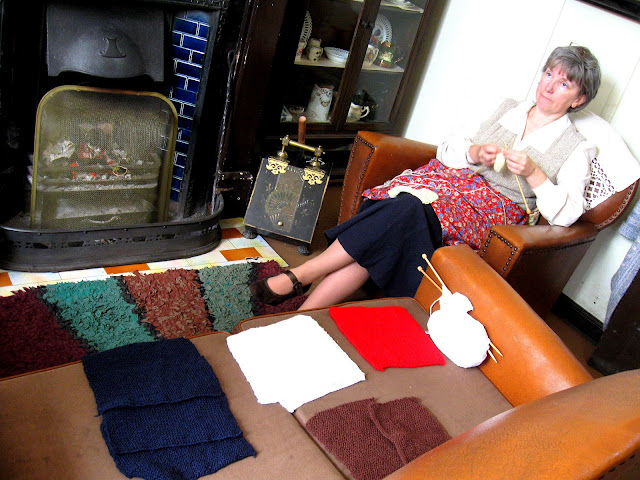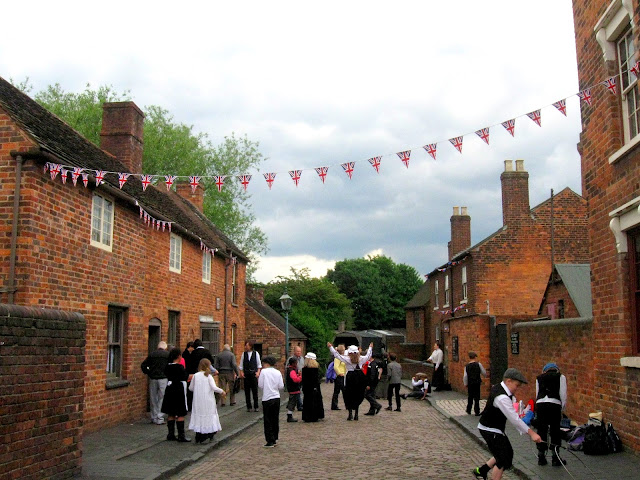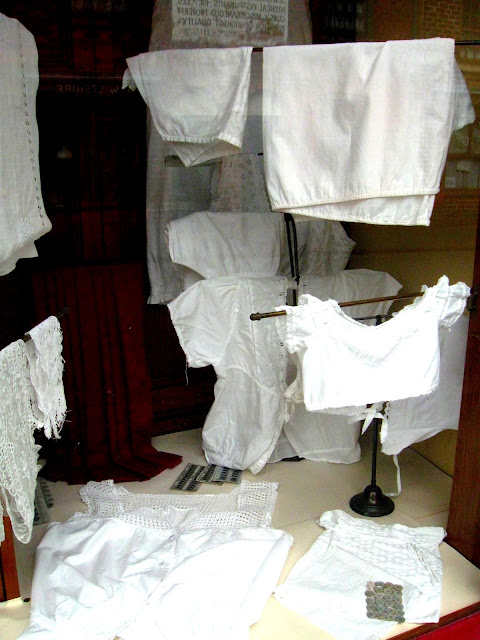After purchasing my flight ticket, I immediately search for the places I should go visit. Since I will be staying with a friend on my 1st week in the UK, I looked for places that are near & easily accessible to her house. Google 'suggested' me this museum. And not long after, the bestie spoke the same place to me. Speak of sisterly instinct, huh. The Black Country Living Museum, definitely is one of the place I so really love to go. Located less than an hour drive from Ernie's place; we decided to give this museum a visit.
A bit of introduction before moving to the pictures.
The BCLM is an open air museum of rebuilt historic buildings. It occupies 26 acres of former industrial land partly reclaimed from a former railway goods yard, disused lime kilns & former coal fits. The museum preserved some important buildings around the Metropolitan Borough; mainly in a specially built village. One very interesting fact is that most of the buildings in the museum are original & relocated from their original sites. As a living museum, these form a base from which knowledgeable local demonstrators portray life in the period of 1850's to 1950's. (source: Wiki)

We departed at 10a from Birmingham. And singgah untuk refuel sebab fuel at Asda is cheaper. Stesen minyak pun ada drive-thru service ah di sana.

I just admire bricked-house...ndak membazir cat. Look natural.

Arrived! Beli entrance ticket...sila jangan convert.

To the left of the main entrance is a conventional exhibition area. Vehicles made in the Black Country; home to some early manufacturers of motors cars & motor cycles.

Trolleybus from Wolverhampton.
The museum is one of the three in the UK with working trolleybuses. Electric trolleybus transport visitors from the main entrance to the rebuilt village situated by the canal basin. But of course, we preferred to just stroll around.

In the Cast Iron House; a semi detached council house which was built as part of a major housing development in Dudley. It is built in 1925 & listed as building of architectural & historical interest.

That woman is real human. *lol* She sits day all day long; knitting. The pieces she made are super neat. And she also answers ur questions regarding the house.


The house interior.

Pure iron! Very heavy indeed. Although cast iron house could be built with relatively unskilled labor, only two pairs of houses were built. Because they proved to be twice as expensive as the brick.

The Rock & Fossil Shop continues the tradition of Dudley's long history of limestone mining for it's early marine fossils. This shop cater for collectors of all age. Unfortunately, it was closed that day. As a souvenir; I think printing the picture above; postcard-like would be nice.

Pitt's House owned by Sam Pitt. Who worked at a nearby quarry & later at the Caponfield Ironworks opposite his house. His wife like other housewives of the period kept pig in a sty & next to earth closet in the garden.

It is a one storey house originally constructed in 1890. It was self built by the Pitt family using second hand bricks. Which resulted in a the uneven brickworks, out of plumb-wall & general homespun look.




Jerushah, the Tilted Cottage. Constructed around 1840, originally situated at Cooper's Bank. Its crooked appearance was caused by the coal digging beneath the house.

The interior reflects the lifestyle of 1910 when occupied by the fairly well off family Joseph Bradley; a colliery clerk. The decoration on the wall as well as the furniture do reflects the term well off for that period I guess.

And few hours of walking, take five for makan time! This is the garden or picnic area at Folkes' Park where we enjoyed our lunch. Homemade & packed with love by dear bestie.

Makan tengah padang nan hijau...even duduk atas batu2 kecil, ini adalah menu untuk kecurkan liur. Ernie's sambal for her nasi lemak certainly is something I can't easily forget.
Nex to the park is the Cradley Heath Workers' Institute building. It is the landmark to one of British most significant yet hidden achievement in labor history. This is also where the cafe is situated.
Nex to the park is the Cradley Heath Workers' Institute building. It is the landmark to one of British most significant yet hidden achievement in labor history. This is also where the cafe is situated.

Upstairs of the building is a memorial exhibition of Mary Macarthur; one of Britain's greatest union leaders. She is the first Labour Party candidate for Stourbridge in 1918.



The Trap Shop. Originally constructed in 1913 is a typical example of a small purpose built factory of the period. It is once a major manufacturer & worldwide export of small animal traps.

Cobbler's Shop ran by Mr. Lawrence Davies. He is a typical of the many shoe repairers in the Black Country in 1930s. Shopkeepers at the period was open all hours & would be called on by a customer if urgent repairing is required. Main work for a shoe repairer was re-soling & heeling. Also would do patching, toe-capping & re-welting. As competition was fierce, the prices were kept low. Although busy, few of them made fortune in the trade.

The children dressed as in the period. They were running & playing at the yard. I really felt like I was transported to the old days; to witnessed all these fun things right before me was truly a blissful experience I would never forget my entire life.

Some of the toys they used.

This chapel was built at Darby Hand, Dudley. Providence Chapel played a central part in the life of the community for 140 years. Not only a centre for Christian belief & practice, it also functioned as a social centre for the community.

Us in between the row of shophouses.

Kaki wayang haruslah alert with this thing, ara? Limelight Cinema ran by a family affair owned by Mr Revil & assisted by his nephew Leslie Ball. His daughter Violet; played record on a wind up gramophones as the musical accompaniment for the silent films!!

The building was moved brick by brick from its original location at Harts Hill where it stood since 1921. Its auditorium could accommodate up to 103 people on wooden benches & 18 padded tip up chairs. Light source for the projectors as the old fashioned method of an electric arch light. Adjacent workshops houses the 2 engines used to generate the electricity required.

Standing next to the Ironmonger's Shop. Established in 1860 supplying both domestic ironmongery & works trade. They sold every conceivable commodity needed by householders & business in the area. They cut keys & mended locks at the back area of the shop.


Replica of Mr Harold Emile Doo's shop. The shop front is original as are the fittings & early 1920s stock. Mr Doo had a considerable reputation locally for his some home made medicines & pills.

Range of early 20th century cosmetics are displayed in this original mahogany cabinets. A demonstrator will explain about the equipment & strange ingredients used by chemists.

Baker's Shop. This is a replica of the one standing in front of the bakery in Birmingan road, Oldbury. The original shop built in 1840 with a single story shop & later extended to double story in 1870. The bakery not only sold bread & cakes but also wines. Range of products are produced by a local bakery but are similar to those sold in the original shop.



Small glasscutter's workshop. Stationery engine at the shop's entrance powers the line shafting driving the cutting frames. And that man is a real glasscutter; inherited the shop from his family. His work can be bought directly from him.

Underground Mine. Black Country was famous for the Staffordshire Thick Coal which lay beneath much of the area. The coal occurred in seams of up to 10m thick & its extraction led to problems of subsidence as the ground dropped to fill the holes left.

Listening to safety instruction before entering; "Into the Thick". Underground experience created by the museum to show how miners work the Thick Coal & other seams in the Black Country in about 1850. It is a drift mine with slopping tunnel down which we could walk into a maze of roadways & working areas.

Out from the dark & black tunnel in 35 minutes. Audio visual & advance techniques; also explanation from the guide were used to bring to life the conditions of the workers in mines. Pretty scary & dangerous I reckoned. Bare in mind, miners back in the period had no insurance policy to cover anything should accident happened to them.

The original steam engine was built by Thomas Newcomen in 1712. And it was the first steam in the world used to pump water from coal mines. After more than 10 years of research, the Museum completed the construction of a full scale replica of that original engine. Rods hang from the outer end of the beam & operates pumps at the bottom of the mine shaft which raise the water to the surface. Unfortunately, the Newcomen Steam Engine was closed to visitor due to repair work being carried out.

Tripping ladies...

At the souvenir shop...last stop before we make the exit. Of course fridge magnet adalah benda harus dibeli.

And I made a souvenir for myself out of a 1pence coin. Through that machine, I only had to pay 1pound & magically turned the coin into a Black Country Museum coin souvenir. Yihaaa!

What's my rate? Ehem, adalah rahsia kerajaan si Err. Sekian.
I know this is too long. Its my first time ever writing such entry. Most of the explanations here; I got from the Black Country Living Museum's website itself. 5 hours we did spent at the museum yet we didn't quite managed to cover the whole area. Despite that I had so much fun exploring, that is what matters the most.
Go read Ernie's version of BCLM...<here>.
eryantierdabdulkarim
2 comments:
siok kan? macam mimpi, masuk zaman dulu. Amazing said!
Siok! Mcm kena transported p sna rasa. Amazing indeed!
Post a Comment